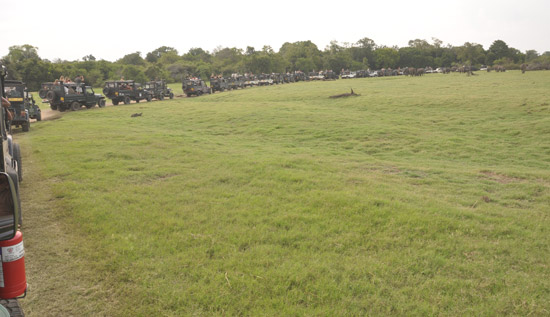Gathering of giants: The beauty and importance of preserving it
‘World Elephant Day’, which was marked on Monday, August 12 is significant to Sri Lanka in many ways. From a tourism aspect, the ‘Elephant Gathering’ in Sri Lanka, now happening in Kaudulla and Minneriya after
a lapse of some years, is a major attraction for wildlife enthusiasts.
The annual Gathering, occurring from July to October, sees smaller elephant herds from surrounding habitats congregate at Minneriya and Kaudulla National Parks. This congregation, fuelled by the diminishing water and food resources in other areas, provides a spectacular sight as the elephants socialise, bathe, drink, feed and potentially find mates. Recognised as the sixth-largest animal gathering globally by Lonely Planet and acclaimed by BBC and CNN, this natural phenomenon offers visitors a unique and memorable experience.

Minneriya: The Gathering and right, a ring of jeeps awaiting photo-op at Kaudulla. Pix by Shan Bandu Weerasinghe
Habarana is the main base for safaris into the nearby Habarana jungle, the Minneriya and Kaudulla National Parks, Huruluwewa Park, and the newest Kalawewa National Reserve, all of which are heavily populated by elephants.
“The Gathering of Giants is not just an event; it is a testament to the beauty of nature and the importance of preserving it. By aligning the Cinnamon Habarana complex with this extraordinary phenomenon, Cinnamon Hotels and Resorts continues to promote sustainable tourism and enhance the global recognition of Sri Lanka’s unique wildlife heritage,” said Chitral Jayatilake – Vice President Cinnamon Nature Trails, the excursions arm of Cinnamon Hotels and Resorts.

Last weekend Cinnamon Hotels hosted a seminar with leading elephant experts – among them Dr. Prithiviraj Fernando – Chairman, Trustee and Scientist for the Centre for Conservation and Research, Dr. Sumith Pilapitiya – Elephant Ethologist and Lead of the National Action Plan for Human-Elephant Conflict Mitigation and Dr. Rohan Pethiyagoda – biodiversity scientist and recent winner of the Linnean Medal, with Guest Speaker Valmik Thapar from India. Thapar has dedicated over 48 years to wildlife and tiger conservation, authoring 39 books and serving on multiple government committees in India.
World Elephant Day was co-founded on August 12, 2012, by Canadian Patricia Sims and the Elephant Reintroduction Foundation of Thailand to focus attention to the urgent plight of Asian and African elephants. In Sri Lanka, the human-elephant conflict, overcrowded national parks, the livelihood of the stakeholders are some of the major issues that have to be addressed.
| A jumbo count | |
| The Department of Wildlife Conservation (DWC) is conducting a countrywide census of wild elephants this weekend – August 17, 18, and 19. According to DWC Director General Chandana Sooriyabandara, the main objectives of the census are to establish new protected areas for elephants, improve existing protected areas, prepare and update strategic plans to mitigate the elephant-human conflict, and balance development activities with conservation needs. Elephant density in Sri Lanka is approximately ten times that of any other Asian country. 10% of the world’s Asian elephant population live in this small island, hence, Sri Lanka offers opportunities of observing Sri Lankan (Asian) elephants in the wild that are unparalleled elsewhere. This charismatic species is losing its ground due to habitat loss and human-elephant conflict. Male elephants with tusks are somewhat rare in Sri Lanka and less than 7% of the island’s male elephants are tuskers, DWC statistics reveal.In the last countrywide census of the elephant population in 2011, it was estimated that Sri Lanka had a minimum of 5,879 elephants. According to the 2011 data, 55.09% of the population were adult elephants, 25.03% were young elephants, 12.04% were calves, and 6.04% were infantsAbout 3,130 survey centres have been established across the country to facilitate the census conducted by staff from the DWC and other government agencies, members of the security forces, private sector personnel, students from higher education institutions, and voluntary participants. |
Searching for an ideal partner? Find your soul mate on Hitad.lk, Sri Lanka's favourite marriage proposals page. With Hitad.lk matrimonial advertisements you have access to thousands of ads from potential suitors who are looking for someone just like you.


